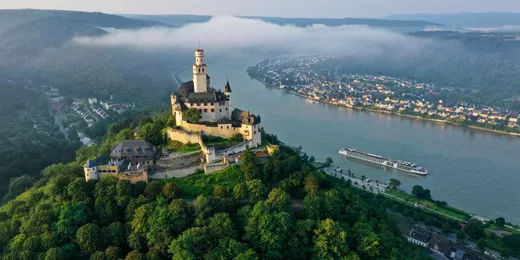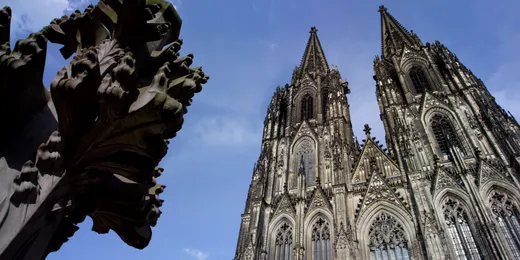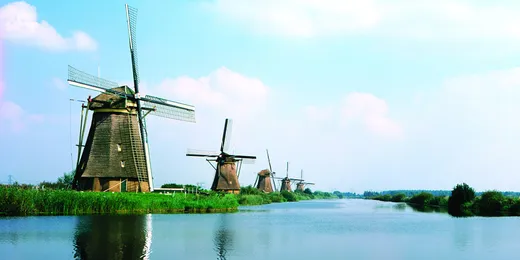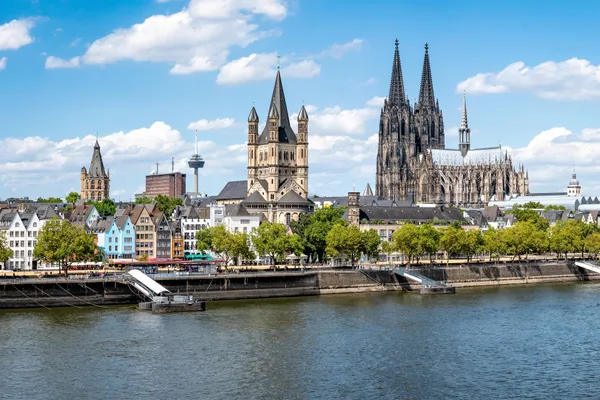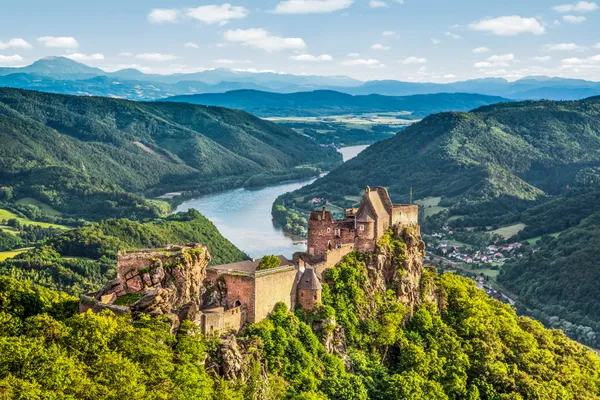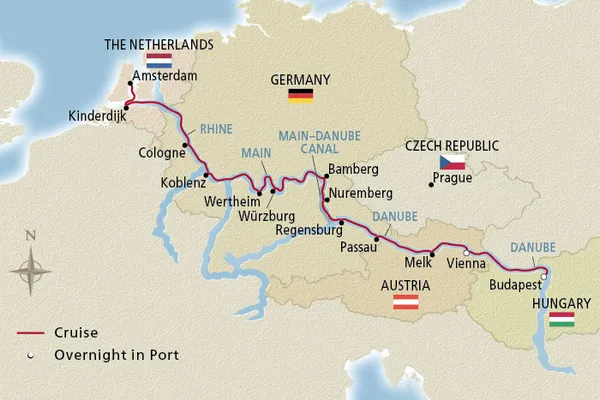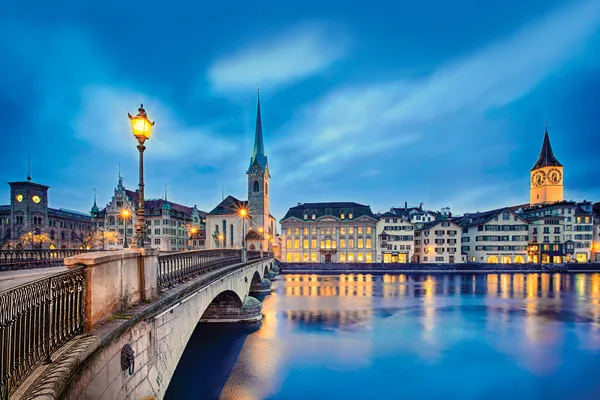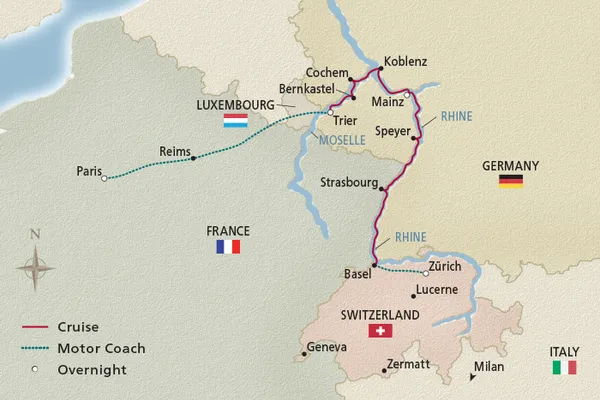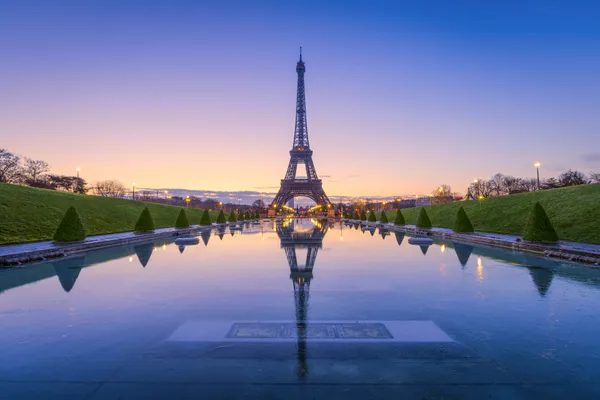
Embark on a Rhine River journey
Rich history and cultural landmarks await your discovery in Germany, France, Switzerland and beyond. Read on to learn about the numerous UNESCO World Heritage Sites along the Rhine River and enhance your understanding of the mechanics behind Kinderdijk’s magnificent windmills in South Holland. Delve into the origins of one of Germany’s most beloved desserts—Black Forest Cake—and explore the heart of Switzerland’s arts and culture scene in Basel, Switzerland.

Rhine
The Rhine River is one of Europe’s major waterways. Its most picturesque stretch flows through the Upper Middle Rhine Valley, known for its castle-topped hillsides, ancient towns, terraced vineyards and medieval ruins. Additionally, the river serves as a vital commercial artery, facilitating trade and transportation between Switzerland, Germany, France and the Netherlands, and supporting economic growth and cultural exchange in these regions. Read on to learn more about the history and significance of the Rhine River.
- In 1932, the German encyclopedia Knaurs Lexikon mistakenly listed the Rhine River’s length as 1,320 km (820 mi) instead of 1,230 km (764 mi), an error corrected by biologist Bruno Kremer in 2010.
- Germans refer to their longest and most important river as "Father Rhine."
- The Rhine River begins as a small stream at the foot of the Swiss Alps and flows through Switzerland, Liechtenstein, Austria, France and Germany before joining the North Sea in Rotterdam, the Netherlands.
- The Rhine serves as the border between France’s Alsace region and Germany’s Baden-Württemberg.
- The Rhine River marked the northernmost frontier of the Roman Empire.
- Many UNESCO World Heritage Sites are located along the Rhine River, including Germany’s Speyer and Cologne Cathedrals and the Netherlands’ windmills at Kinderdijk.
- One of the Upper Middle Rhine Valley’s most spectacular sights is the 430-foot Lorelei Rock, associated with the legend of the maiden Lorelei.
- The Rhine River is a vital natural resource, providing significant drinking water to southern Germany.
- Today, ship travel between Basel and the North Sea is safe and convenient, but historically, castle-dwelling robber barons and customs stations made passage along the Rhine difficult until the Rhine Shipping Act of 1831.
Petite France, the jewel of Strasbourg
Strasbourg, the largest port on the Upper Rhine, offers a unique blend of cultural influences due to its location at the border of France and Germany. One of the most popular districts for both visitors and locals is the charming quarter known as Petite France.
Petite France is renowned for its half-timbered houses, picturesque canals and flower-filled squares. This district is part of Strasbourg’s Grand Île, a UNESCO World Heritage Site, and is considered the city’s most romantic spot. Visitors can cross the four channels that flow through the heart of Petite France via the Ponts Couverts ("Covered Bridges"), a set of 13th-century defensive bridges that were once covered with wooden roofs.
Admire the Vauban Barrage, a system of locks and dams built in 1690, and enjoy the panoramic views it offers. The St. Thomas Church, which has existed since the 12th century and became a Protestant church in 1529, features the white marble tomb of the Maréchal de Saxe, decorated with animal figures representing the places where he fought for King Louis XV. Another highlight is the Tanner’s Building, a riverside guild house that is one of the most photographed structures in the quarter.
Windmills of Kinderdijk, South Holland
Located in Alblasserwaard province, Kinderdijk is a village community in South Holland, a region that has long been shaped by Rhine Delta waters. Kinderdijk is most known for its 19 remarkably preserved 18th-century windmills.
UNESCO World Heritage Site: Granted UNESCO World Heritage Site status in 1997, the windmills of Kinderdijk are used to pump water from the polders using internal or external scoops into reservoirs on two levels. At one time, there were more than 150 windmills in the Alblasserwaard and Vijfheerenlanden area; today, they total just 28, with 19 located in the Kinderdijk area.
De Nederwaard Mills: The eight mills that survive on De Nederwaard were all built in 1738. These bonnet mills—meaning only the top section revolves with the wind—are built from brick and have large sails that come within one foot of the ground, earning them the nickname "ground sailors."
De Overwaard Mills: An additional eight mills are also found on De Overwaard, all dating from 1740, although one was reconstructed in the 1980s.
In the words of the UNESCO World Heritage Center: "The Kinderdijk-Elshout mill network is an outstanding manmade landscape that bears powerful testimony to human ingenuity and fortitude over nearly a millennium in draining and protecting an area by the development and application of hydraulic technology."

-
Architecture—The best castle to visit on the Rhine River
Marksburg Castle is well worth visiting along the Rhine River. It is a well-preserved structure and renowned for being the region’s only medieval castle that has never been destroyed. Perched nearly 300 ft (90 m) above the water at Braubach, it also offers stunning views of the Rhine Valley below.
The butter-churn tower at Marksburg Castle, also known as a bergfried, is a distinctive architectural feature of this structure. This tower has an upper section with a smaller diameter than the lower section, resembling a butter churn. This design provides several advantages—the ledge where the lower tower meets the upper tower acts as a useful walkway or fighting platform, while the upper tower can be used as a lookout or defensive position.
Visitors may have an opportunity to walk across the rough-hewn stone passageways as they tour the citadel. Narrow, winding staircases offer views of the wine cellar, a bedroom, dining area and the impressive kitchen of the Gothic Hall building. Another highlight is the Gimbel Collection, with its twelve life-size figurines detailing changes to armor, weaponry and combat techniques from ancient times to the early modern period.
-
Arts & culture—Basel, Switzerland
The Swiss city of Basel is home to more than three dozen museums and a plethora of art galleries and non-permanent installations and exhibits. One of its most renowned institutions is the Basel Kunstmuseum. In 1661, it became the first art collection to be made accessible to the public in Europe. Basel Kunstmuseum is also the largest art museum in Switzerland—its modernist collection has grown to such an extent that a second building was constructed across the street, accessible by a tunnel.
The Fondation Beyeler is another excellent museum to explore in Basel. It boasts an astounding collection of 19th- and 20th-century works by artists like Paul Cézanne, Vincent van Gogh, Pablo Picasso, Mark Rothko, Joan Miró, Andy Warhol, Roy Liechtenstein, Max Ernst and many others.
In addition to its museums, the city also hosts Art Basel, a renowned annual international art fair that is a showcase for contemporary and modern art. Its popularity and success led to the launch of partner Art Basel fairs in Miami and Hong Kong.
-
Cuisine—The history of Black Forest Cake
Black Forest Cake, also known as Schwarzwälder Kirschtorte, is a classic dessert famous for its layers of chocolate cake, cherries, lashings of whipped cream and drizzle of kirsch (cherry brandy). This iconic treat comes from Germany’s Black Forest region, near the Rhine River Valley, where cherries and kirsch are local specialties. While its exact origins are debated, the cake likely evolved from traditional desserts in the area and became popular in the early 1900s, with the first official recipe being recorded in 1934.
The cake’s name reflects its roots—the dense, dark forests of Germany’s Black Forest region. Its layers of chocolate sponge, cherry filling and whipped cream are typically topped with chocolate shavings to resemble the forest’s trees. Over time, Black Forest Cake has become a favorite around the world. Whether enjoyed at a celebration or as a sweet afternoon treat, this dessert remains a timeless symbol of German baking tradition.
Rhine Highlights
The Rhine River takes you into the heart of Middle Europe, where stately castles, fairytale villages and cultural centers have long been witnesses to history. Traveling through the Netherlands, Germany, France and Switzerland reveals historic treasures, natural beauty and vibrant capitals. Here are some sample highlights found along the Rhine River:
- Amsterdam’s charming canals and gabled houses
- Windmills of Kinderdijk, a UNESCO World Heritage Site
- Rüdesheim’s wine-growing region, the Rheingau
- Marksburg Castle, perched above scenic Braubach
- Delightful Strasbourg, home to a distinct French-German culture
- Breathtaking views of the legendary Black Forest
- Charming Colmar’s medieval “Little Venice” artistic quarter
- Kölsch—a light, crisp beer—that is brewed only in Cologne
- Mythical Lorelei Rock at the Middle Rhine Gorge
- Stunning Heidelberg, inspiration to writers and philosophers
Destination Insight Videos
-
Romantic Middle Rhine (2:40)
Experience the majestic stretch of the Rhine River known affectionately as the “Romantic Middle Rhine.” Winding past quaint villages and medieval castles, this idyllic waterway offers a window into the past and unmatched vistas.
-
Gothic Cologne Cathedral (5:13)
Explore the history of this ornate architectural masterpiece. Towering over the Rhine, the majestic Cologne cathedral has been a beacon for pilgrims from around the world for centuries.
-
Follow us to the famous windmills of Kinderdijk (14:36)
Journey with us to the Dutch countryside as we explore the iconic windmills of Kinderdijk, a UNESCO World Heritage Site. Get a glimpse at the inner workings of these technological marvels—still in operation today—and learn about the fascinating history of these windmills, which date back hundreds of years. During the tour, we are also introduced to the Jantina, a 125-year-old vessel that has been restored to carry passengers to the Blokker Windmill—an experience you can enjoy first-hand when sailing with us in the Netherlands. Following our explorations, learn more about this celebrated Dutch destination during a question and answer session with Jan-Willem de Winter, Head of Product Development for Kinderdijk World Heritage.
Rhine Travel FAQ
All-Inclusive Itineraries—Rhine
Choose one of our enriching, all-inclusive voyages and discover the many benefits of exploring in Viking comfort.



